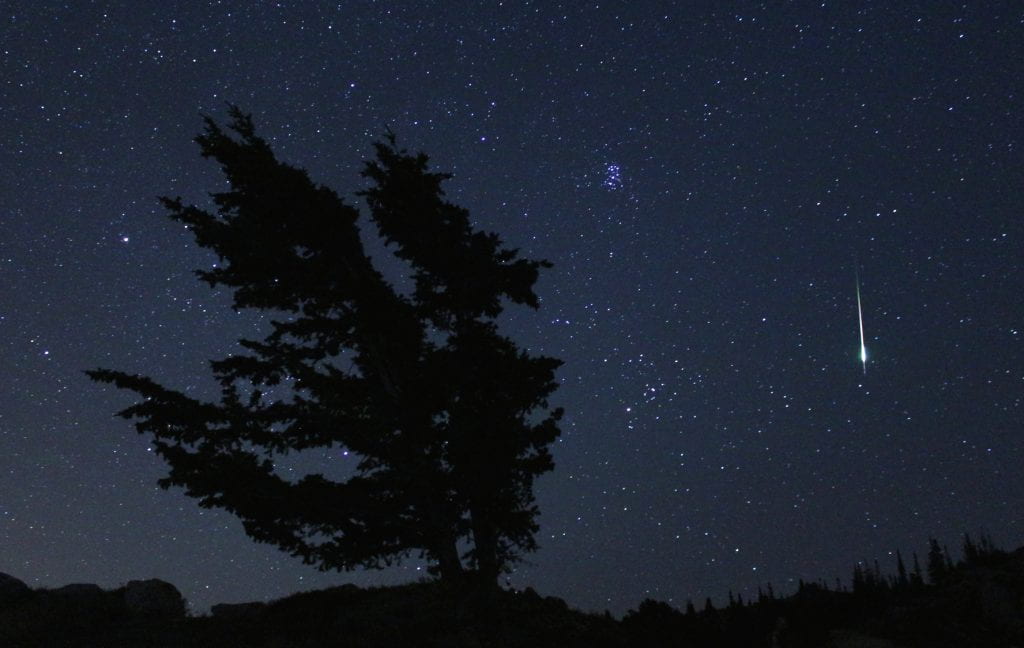Meteors
This is really simple
- If you found a rock, it might be a meteorite, but it is definitely not a meteor.
- If you saw a meteor and later found a rock, then the rock is not a meteorite.
- If you found a rock after seeing a meteor shower, then the rock is not a meteorite.

A meteor is like lightning – You cannot hold it in your hand
A meteor (shooting star, fireball, bolide) is the visible streak of light in the sky from a meteoroid or micrometeoroid passing through the upper atmosphere of the Earth. The meteoroid compresses the air, which causes the exterior of the meteoroid to heat and glow (incandesce). The meteoroid sheds glowing material in its wake, causing the streak in the sky. There is a meteorite there, but you cannot see it. If the rock hits the ground, then it is a meteorite. The rock is not a meteor.
The rock you found is not a meteorite
Meteoroids enter Earth’s atmosphere at speeds typically of 12-40 km/s (27,000-90,000 mph) relative to the Earth. That is equivalent to going from New York to Los Angeles in 2 to 6 minutes.

Meteors stop incandescing (the light goes out) tens of kilometers above the Earth’s surface. It takes a few minutes for any surviving fragments to fall to the ground during the “dark flight.” They keep moving in same general direction, but their fall becomes more vertical and is subject to wind speed and direction. The fragments land at terminal velocity, about 100-200 meters/second (220-450 miles per hour). Meteorites are not glowing when they hit the ground and they are not hot. Also, meteorites are much smaller than most people think they are, typically a few centimeters in size. This all means that the meteorite fragments land far from where you last saw the meteor and there is no way that observers at a single point on the Earth’s surface are going to find fragments of the meteorite perhaps unless there is a video of the video.
For another opinion, see also this.
From www.newshub.co.nz
March 23, 2024
New Zealand’s 10th meteorite discovered by couple sitting in Queenstown spa
…
“We saw a fireball streak across the sky and it was really exciting… I’ve never seen one before,” Behan said. “We were just speechless.”
Incredibly, Behan happens to be a meteorite enthusiast – in fact, he has a specialist meteorite camera mounted near his spa.
“[It] points in the same direction that would have captured footage of it,” he said.
And it did. He raced inside because, thankfully, he knew who to report the sighting to.
“It honestly looked like it landed just over the hill from where we live… but turns out it landed 170 km away,” Behan said. “They were able to use the data my camera collected to start the search.”
…
Meteor showers
People have been watching meteor showers, such as the Perseids in early August, for thousands of years.
Space.com: “Perseid meteoroids (which is what they’re called while in space) are fast. They enter Earth’s atmosphere (and are then called meteors) at roughly 133,200 mph (60 kilometers per second) relative to the planet. Most are the size of sand grains; a few are as big as peas or marbles. Almost none hit the ground, but if one does, it’s called a meteorite.”
For all meteor showers, the meteors you see are made almost exclusively by sand- to pea-sized objects that ablate away in the atmosphere and never hit the ground. If you see a meteor during an annual meteor shower, then you are not going to find the meteorite.